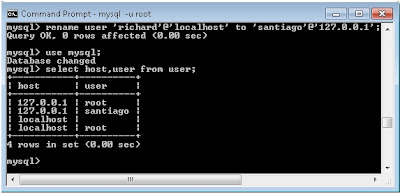Retrieve the birthdate and address of the employee whose name is 'John B.
Smith'.
Q0: SELECT BDATE, ADDRESS
FROM EMPLOYEE
WHERE FNAME='John' AND MINIT='B’
AND LNAME='Smith’;
FROM EMPLOYEE
WHERE FNAME='John' AND MINIT='B’
AND LNAME='Smith’;
Retrieve the name and address of all employees who
work for the 'Research' department.
Q1: SELECT FNAME,
LNAME, ADDRESS FROM EMPLOYEE JOIN DEPARTMENT ON EMPLOYEE.DNUMBER =
DEPARTMENT.DNO WHERE DNAME='Research’;
For every project located in
'Stafford', list the project number, the controlling department number, and the
department manager's last name, address, and birthdate.
Q2: SELECT PNUMBER, DNUM, LNAME, BDATE, ADDRESS FROM PROJECT, DEPARTMENT,
EMPLOYEE WHERE DNUM=DNUMBER AND MGRSSN=SSN AND PLOCATION=‘Stafford’;
For each employee, retrieve the employee's name, and
the name of his or her immediate supervisor.
Q8: SELECT
E.FNAME, E.LNAME, S.FNAME, S.LNAME FROM EMPLOYEE E S
WHERE E.SUPERSSN=S.SSN;
WHERE E.SUPERSSN=S.SSN;
Retrieve the SSN values for all employees.
Q9: SELECT SSN FROM EMPLOYEE
Retrieve ssn and dname values for all employee and
department.
Q10: SELECT SSN,
DNAME FROM EMPLOYEE, DEPARTMENT;
With
the use of *, retrieve all the attribute values of the selected tuples.
Q1c: SELECT * FROM EMPLOYEE WHERE DNO=5;
SELECT * FROM EMPLOYEE
JOIN DEPARTMENT ON DNO=DNUMBER WHERE DNAME='Research’
;
For example, the result of Q11 may have duplicate
SALARY values whereas Q11A does not have any duplicate values
Q11A: SELECT
DISTINCT SALARY FROM EMPLOYEE;
Make a list of all project numbers for projects that
involve an employee whose last name is 'Smith' as a worker or as a manager of
the department that controls the project.
Q4: (SELECT PNAME FROM PROJECT, DEPARTMENT, EMPLOYEE WHERE
DNUM=DNUMBER AND MGRSSN=SSN AND LNAME='Smith') UNION (SELECT PNAME FROM
PROJECT, WORKS_ON, EMPLOYEE WHERE PNUMBER=PNO AND ESSN=SSN AND LNAME='Smith') ;
Retrieve the name and address of all employees who
work for the 'Research' department.
QQ1. SELECT FNAME, LNAME,
ADDRESS FROM EMPLOYEE WHERE DNO IN
(SELECT DNUMBER FROM DEPARTMENT WHERE
DNAME='Research' );
Retrieve the name of each employee who has a
dependent with the same first name as the employee.
SELECT E.FNAME, E.LNAME FROM EMPLOYEE AS
E WHERE E.SSN IN (SELECT ESSN FROM DEPENDENT WHERE ESSN=E.SSN AND E.FNAME=DEPENDENT_NAME)
Retrieve the names of employees who have no
dependents.
SELECT FNAME,
LNAME FROM EMPLOYEE WHERE NOT
EXISTS (SELECT * FROM DEPENDENT WHERE SSN=ESSN);
Retrieve the social security numbers of all
employees who work on project number 1, 2, or 3.
SELECT DISTINCT
ESSN FROM WORKS_ON WHERE PNO IN (1, 2,
3)
;
These are different
examples of JOIN.
QQ2. SELECT E.FNAME,
E.LNAME, S.FNAME, S.LNAME FROM (EMPLOYEE E LEFT OUTER JOIN EMPLOYEE S ON E.SUPERSSN=S.SSN);
SELECT FNAME, LNAME, ADDRESS FROM (EMPLOYEE JOIN DEPARTMENT ON DNUMBER=DNO) WHERE DNAME='Research’;
SELECT PNUMBER, DNUM, LNAME,
BDATE, ADDRESS FROM (PROJECT JOIN DEPARTMENT ON DNUM=DNUMBER) JOIN EMPLOYEE ON
MGRSSN=SSN WHERE PLOCATION='Stafford’
Find
the maximum salary, the minimum salary, and the average salary among all
employees.
SELECT MAX(SALARY), MIN(SALARY),
AVG(SALARY) FROM EMPLOYEE;
Find the
maximum salary, the minimum salary, and the average salary among employees who
work for the 'Research' department.
SELECT MAX(SALARY), MIN(SALARY), AVG(SALARY) FROM EMPLOYEE JOIN DEPARTMENT ON DNO=DNUMBER
WHERE DNAME='Research‘;
WHERE DNAME='Research‘;
Queries 17 and 18: Retrieve the
total number of employees in the company (Q17), and the number of employees in
the 'Research' department (Q18).
SELECT COUNT
(*) FROM EMPLOYEE;
For each department,
retrieve the department number, the number of employees in the department, and
their average salary.
Qq5. SELECT DNO, COUNT (*), AVG (SALARY) FROM
EMPLOYEE GROUP BY DNO;
For each project, retrieve the project number,
project name, and the number of employees who work on that project.
SELECT PNUMBER, PNAME, COUNT(*) FROM PROJECT JOIN WORKS_ON ON
PNUMBER=PNO GROUP BY PNUMBER;
For each project on which more than two employees
work , retrieve the project number, project name, and the number of
employees who work on that project.
SELECT PNUMBER, PNAME, COUNT (*) FROM PROJECT,
WORKS_ON WHERE PNUMBER=PNO GROUP BY PNUMBER, PNAME HAVING COUNT (*) > 2
;
SELECT FNAME, LNAME, SALARY, 1.1*SALARY FROM EMPLOYEE, WORKS_ON, PROJECT WHERE SSN=ESSN AND
PNO=PNUMBER AND PNAME='ProductX’;
Retrieve a list of employees and the projects each
works in, ordered by the employee's department, and within each department
ordered alphabetically by employee last name.
SELECT DNAME, LNAME, FNAME, PNAME FROM DEPARTMENT,
EMPLOYEE, WORKS_ON, PROJECT WHERE DNUMBER=DNO AND SSN=ESSN AND PNO=PNUMBER ORDER BY DNAME, LNAME


































